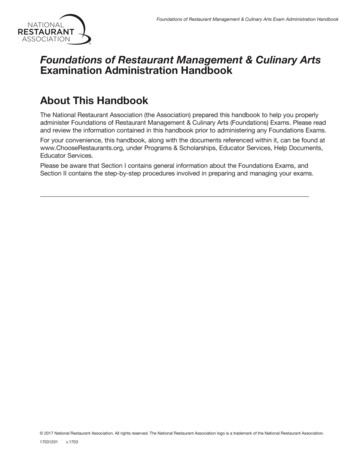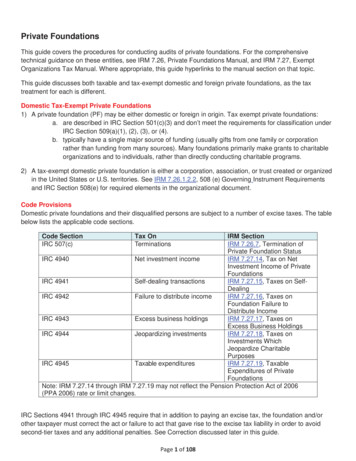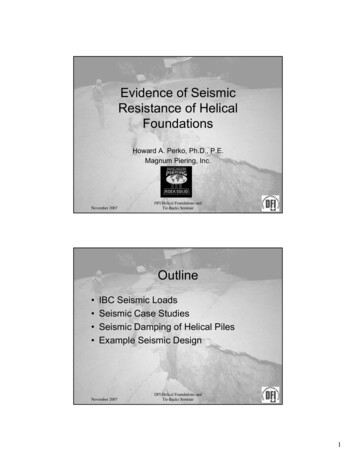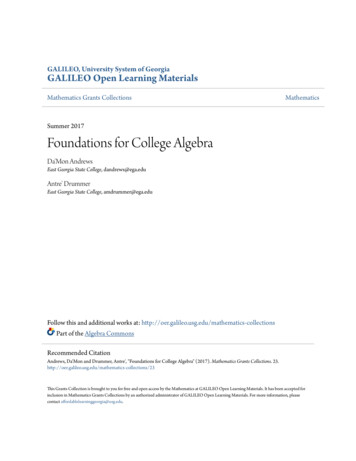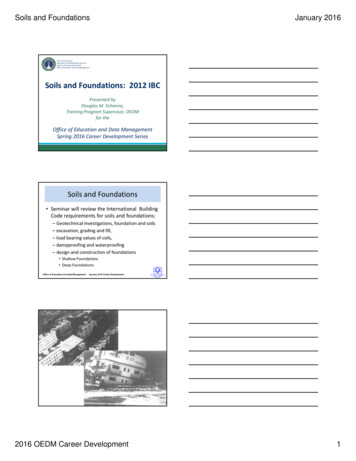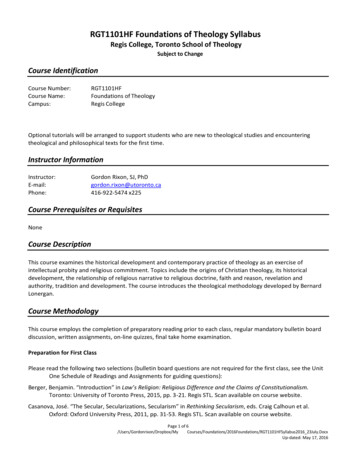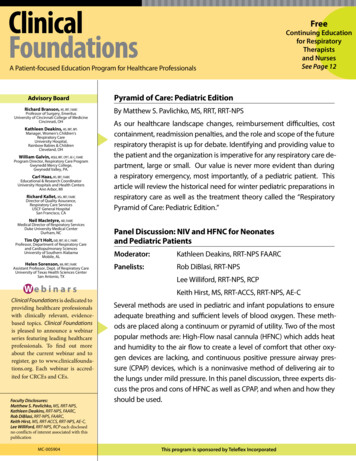
Transcription
ClinicalFoundationsFreeA Patient-focused Education Program for Healthcare ProfessionalsAdvisory BoardRichard Branson, MS, RRT, FAARCProfessor of Surgery, EmeritusUniversity of Cincinnati College of MedicineCincinnati, OHKathleen Deakins, MS, RRT, NPSManager, Women’s Children’sRespiratory CareUniversity Hospital,Rainbow Babies & ChildrenCleveland, OHWilliam Galvin, MSEd, RRT, CPFT, AE-C, FAARCProgram Director, Respiratory Care ProgramGwynedd Mercy College,Gwynedd Valley, PA.Carl Haas, MS, RRT, FAARCEducational & Research CoordinatorUniversity Hospitals and Health CentersAnn Arbor, MIRichard Kallet, MSc, RRT, FAARCDirector of Quality Assurance,Respiratory Care ServicesUSCF General HospitalSan Francisco, CAContinuing Educationfor RespiratoryTherapistsand NursesSee Page 12Pyramid of Care: Pediatric EditionBy Matthew S. Pavlichko, MS, RRT, RRT-NPSAs our healthcare landscape changes, reimbursement difficulties, costcontainment, readmission penalties, and the role and scope of the futurerespiratory therapist is up for debate. Identifying and providing value tothe patient and the organization is imperative for any respiratory care department, large or small. Our value is never more evident than duringa respiratory emergency, most importantly, of a pediatric patient. Thisarticle will review the historical need for winter pediatric preparations inrespiratory care as well as the treatment theory called the “RespiratoryPyramid of Care: Pediatric Edition.”Neil MacIntyre, MD, FAARCMedical Director of Respiratory ServicesDuke University Medical CenterDurham, NCTim Op’t Holt, EdD, RRT, AE-C, FAARCProfessor, Department of Respiratory Careand Cardiopulmonary SciencesUniversity of Southern AlabamaMobile, ALHelen Sorenson, MA, RRT, FAARCAssistant Professor, Dept. of Respiratory CareUniversity of Texas Health Sciences CenterSan Antonio, TXWebinarsClinical Foundations is dedicated toproviding healthcare professionalswith clinically relevant, evidencebased topics. Clinical Foundationsis pleased to announce a webinarseries featuring leading healthcareprofessionals. To find out moreabout the current webinar and toregister, go to www.clinicalfoundations.org. Each webinar is accredited for CRCEs and CEs.Faculty Disclosures:Matthew S. Pavlichko, MS, RRT-NPS,Kathleen Deakins, RRT-NPS, FAARC,Rob DiBlasi, RRT-NPS, FAARC,Keith Hirst, MS, RRT-ACCS, RRT-NPS, AE-C,Lee Williford, RRT-NPS, RCP each disclosedno conflicts of interest associated with thispublicationMC-005904Panel Discussion: NIV and HFNC for Neonatesand Pediatric PatientsModerator:Kathleen Deakins, RRT-NPS FAARCPanelists:Rob DiBlasi, RRT-NPSLee Williford, RRT-NPS, RCPKeith Hirst, MS, RRT-ACCS, RRT-NPS, AE-CSeveral methods are used in pediatric and infant populations to ensureadequate breathing and sufficient levels of blood oxygen. These methods are placed along a continuum or pyramid of utility. Two of the mostpopular methods are: High-Flow nasal cannula (HFNC) which adds heatand humidity to the air flow to create a level of comfort that other oxygen devices are lacking, and continuous positive pressure airway pressure (CPAP) devices, which is a noninvasive method of delivering air tothe lungs under mild pressure. In this panel discussion, three experts discuss the pros and cons of HFNC as well as CPAP, and when and how theyshould be used.This program is sponsored by Teleflex Incorporated
Clinical FoundationsCare” translates well to the pediatric patient population.(Figure 1)The pyramid’s shape is the most important concept. The foundation of thepyramid serves the largest population andhas the least complexity; i.e., patients onroom air. As one moves up the pyramid,one shifts in treatments that are highercost and complexity but are necessary fora smaller number of patients. When pawill describe the Respiratory Pyramid of tients’ conditions worsen, they advanceCare within the scope of pediatrics. Its up the pyramid, but when they improve,purpose, is to provide comprehensive in- they are weaned down the pyramid. Eachsight into the respiratory treatment strat- treatment meets the patient’s needs, butegy of the sick child and to better prepare each has nuances that can serve as a conclinicians for the child who will inevitably duit or a barrier to care. Each is describedin more in depth below.arrive.Pyramid of Care:Pediatric EditionATreatments that Resolve Hypoxemia/HypoxiaWhen the body’s partial pressure ofarterial oxygen (PaO2) falls below normallevels, hypoxemia is present. Hypoxemiacan be caused by hypoventilation, shunting, diffusion defects, abnormal hemoglobin, anemia, and/or poor perfusion. Signsand symptoms include increased work ofbreathing (WOB), tachypnea, shortnessof breath, tachycardia, poor perfusion,and potential neurological deficit.5 Hypoxemia can occur during severe trauma,shock, cyanide and carbon monoxide poisoning, cardiac arrest, and perioperativeemergencies.In 2016, The World Health Organization (WHO) created the Oxygen TherapyRespiratory Pyramid of CareInvasiveVentilationHigh Flow/High FIO2Oxygen TherapyLow Flow/Low FIO2OIxygen TherapyRoom AirFigure 1.www.clinicalfoundations.orgityHeated, HumidifiedOxygen Therapy (HFNC)exNoninvasiveVentilationAdjunctive TherapiesExtremeMeasurespl2What is the Pyramid of Care?The Council for Advances in Respiratory Therapy developed the theory of“Navigating the Respiratory Pyramid ofCare” in 2010. Led by David Vines, PhD,RRT, FAARC, the council (comprised ofexpert respiratory care thought leadersfrom across the country) developed anextensive, peer-reviewed educational curriculum to create a comprehensive understanding of oxygen therapy and ventilatory support.5 This curriculum describesthe treatment selection strategy for adultpatients with respiratory compromise,as well as how to navigate the severity oftheir illness, from worsening progressionto weaning. Although, initially created tocare for the adult patient, the “Pyramid ofmCos our healthcare landscapechanges, reimbursement difficulties, cost containment, readmission penalties, and the roleand scope of the future respiratory therapist is up for debate. Identifying and providing value to the patient and the organization is imperative for any respiratorycare department, large or small. Our valueis never more evident than during a respiratory emergency, most importantly, of apediatric patient. This article will reviewthe historical need for winter pediatricpreparations in respiratory care as well asthe treatment theory called the “Respiratory Pyramid of Care: Pediatric Edition.”The Emergency Medicine Networkhas recorded that there are 5,273 EDs inthe US.1 However, of those 5,273 emergency departments, only 220 reside in achildren’s hospital (CHA).2 These statistics lead to the assumption that most pediatric ED visits are performed outside thewalls of a children’s hospital. Chamberlainand colleagues described the scope of thisphenomenon in 2013,3 when they reported that up to 90% of all pediatric emergency cases did not receive care at a pediatricspecialty hospital. In addition, accordingto the Agency for Healthcare Researchand Quality (AHRQ),4 only 5% of pediatric ED visits result in admission to thesame hospital. The AHRQ also reportedthat in 2015, the most common reason forpediatric patients to visit the ED was forrespiratory disorders, especially duringwinter months.4The ED is not the only location thatdeals with respiratory emergencies. Manyinpatient pediatric units and neonatal intensive care nurseries across the countryreside outside the wall of a children’s hospital. This phenomenon places enormouspressure to deliver high quality care in alow-volume, high-risk patient populationin settings where the least amount of experience, knowledge, and resources areavailable. Is pediatric respiratory emergency truly “low-volume”? This moduleCostBy Matthew S. Pavlichko, MS, RRT, RRT-NPS
Clinical Foundationsfor Children Guide, which describes, indetail, assessment and identification,treatment strategies, and monitoring ofchildren on oxygen therapy.6 PaO2 can beconsidered as a diagnosis of hypoxemia,but the measure of PaO2 requires an invasive arterial blood gas (ABG) test. TheWHO identified a target oxygen saturation (SpO2), which is a non-invasive measure of tissue oxygenation, to adequatelyreflect hypoxemia and the response totherapy that is appropriate for children.This target goal is defined as a SpO2 of90-94%6 via pulse oximeter. Treatmentshould target that goal.High-flow Nasal CanualaRoom AirAlthough not addressed by Vines andcolleagues, room air is the best option formost pediatric patients, even those whopresent with respiratory illness. Oxygen isa prescribed therapeutic intervention thathas benefits but also side effects. If a patient is adequately oxygenating, oxygen iscontraindicated. Hyperoxia leads to oxygen toxicity, alveolar damage, absorptionatelectasis, etc.7 In addition, oxygen therapy devices are difficult to manage withpediatric patients due to lack of patientunderstanding. Oxygen therapy is only effective when the application is consistent.Comfort can overcome reason, but whenroom air is adequate, it is always the bestoption.Low-Flow – Variable FiO2 DevicesWhen oxygen is needed, the first stepof the Pyramid of Care is low-flow oxygen.A low-flow oxygen device is described byEgan as an oxygen device that delivers aflow rate less than the inspiratory flow rateof the patient, thus creating variable FiO2due to respiratory rate and tidal volume.8Examples of low-flow devices are a standard nasal cannula, simple mask, air entrainment mask, and a large-volume aerosol mask. All these devices deliver FiO2 tothe patient less than that which is set onthe flowmeter. Three of four use a mask asan interface. As pediatric patients come inall shapes and sizes, so do masks. As discussed in the previous section, effectiveness requires consistency of therapy, socomfort is very important. Have you everput a mask on a 2-year old? For reasons ofcomfort and compliance, the nasal cannula is the standard low-flow delivery devicefor pediatrics.The nasal cannula is the most comfortable option, comparatively speaking.cludes the recommendation to resuscitateinfants using 100% FiO2 to meet target saturations over time.9,10 Air-oxygenblenders, found routinely in the deliveryroom, are becoming popular for delivering oxygen therapy to all children. The useof blenders allows the clinician to deliverflow and FiO2 independent of one another.FiO2 can be adjusted to meet SpO2 targets,and flow can be adjusted to meet workof breathing targets. What if an oxygenHigh-Flow – Fixed FiO2 DevicesWhen a higher level of FiO2 is re- delivery device could give precise/prequired, the low-flow device may be inad- scribed FiO2 while using flow as a therapyequate and a high-flow fixed FiO2 may be and be comfortable for pediatric patients?needed. In contrast to low-flow, a highflow device is one that meets or exceeds Heated Humidified HFNCthe patient’s inspiratory demand thusThe next step of the pyramid is theproviding a stable or fixed FiO2. The FiO2 high-flow nasal cannula (HFNC). Thisat the blender flowmeter is what is deliv- very popular respiratory modality hasered to the patient with minimal air en- applications in both adults and pediattrainment. These include non-rebreather rics,11,12 but its name is misleading. HFNCmasks, dual large-volume aerosol masks, only describes part of the therapy. The keyand high-flow/high FiO2 air entrainment difference between this and a standard namasks. Once again, masks are difficult op- sal cannula is not the flow rate, but rathertions for pediatric patients, which creates the addition of heat and humidity. Thea challenge to the delivery of high oxygen addition of heat and humidity, which crevolumes to children.ates a level of comfort that other oxygendevices are lacking. Add a blender andAir-Oxygen Blendersyou have a heated, humidified high-flowThe use of low-flow and high-flow ox- nasal cannula with customizable FiO2. Itygen devices creates a potential problem meets the major challenges in pediatricfor respiratory therapists. Flow and FiO2 oxygen therapy, comfort, with consistentthat are dependent on each other does application of therapy, with FiO2 and flownot cause a major problem for adults but autonomously delivered.does present a barrier to the treatment ofHeat and humidity at or near bodychildren. FiO2 is the treatment needed to temperature and pressure saturatedmeet the therapeutic SpO2 goal of 90-94%, (BTPS), delivering flow via nasal interfacebut FiO2 is flow dependent. Or is it?provides comfort because it does not imAs described above, hyperoxia should pede the work of the nose. Heated humidalways be avoided. In 2010, the AHA and ification prevents airway cooling, discomAAP changed the NRP algorithm to re- fort, and intolerance of high-flows. It alsoflect a strategy to reduce the detrimental prevents water loss, the cause of thickenedeffects of hyperoxia. The algorithm in- nasal secretions, and inflammation, theThey come in many sizes, can be humidified using a bubble humidifier, and noware made of very soft material to maximise comfort. Patients can talk and eatwhile fitted with a nasal cannula. The initial application may be difficult dependingon the patient, but the standard nasal cannula should be the first option for oxygentherapy.www.clinicalfoundations.org3
Clinical Foundationscause of increased airway resistance. Heatand humidity can make any nasal cannulaan HFNC, even those at low-flow rates.Just as with a standard low-flow nasal cannula, the interface provides for consistenttherapy due to its comfort and convenience.Just like high-flow, fixed FiO2 devices,an HFNC can meet or exceed the patient’sinspiratory flow rate, thus delivering exactFiO2 to help prevent hyperoxia. Using ahigh-flow/blender system, the clinicianmay deliver precise flows and FiO2 tomeet the patient’s needs.5 For example, anasal cannula delivering heated humidityat a flow rate of 20 L/min at 30% FiO2 ispossible using this system. FiO2 independent of flow is key to delivering specificoxygen therapy to children.One cannot discuss HFNC withoutdiscussing airway pressure created by flowor PEEP. There is an enormous amount ofliterature on this subject; does it providebenefit or detriment because the pressurecreated is not fixed? HFNC does createPEEP, but it varies based on nares size,cannula size, and respiratory pattern.13 In2004, Bamford & Lain stated that highflow delivered through a non-occludingnasal cannula does create a small, but consistent, increase in oropharyngeal pressure.14 In their model, 36 L/min created 3cm H2O pressure to the oropharynx. Themost important part of their statement is“through a non-occluding” cannula14. Thepurpose of HFNC therapy is to provideflow; PEEP is inadvertent. HFNC therapyis not (CPAP) therapy; thus its own category on the pyramid below CPAP.Initial settings for HFNC are debatedas well. Recent studies have stated that 1.5to 2 L/min/kg is safe and effective for pediatric patients.15,16 Safe is a relative term,based on the resources available (i.e. proximity and pediatric intensive care). Signsof clinical improvement, oxygenation,and WOB should guide your care. Closeand careful monitoring is required.Non-Invasive Ventilation - CPAPWith some pediatric patients, flowdoes not provide enough therapeuticvalue; pressure is required to improvehypoxia. The next escalation of thepyramid is CPAP therapy. The patientcare goals remain the same: improveoxygenation and WOB. The challengewith CPAP therapy is its application: fewoptimal patient interfaces are availablewhich is especially challenging withchildren. To create pressure, minimal orno leak is required (in contrast to HFNC).The mask or interface can be tight fitting,feel “suffocating”, and potentially causeskin breakdown17 (picture of patienton CPAP). The American Academy ofRespiratory Medicine Clinical PracticeGuidelines suggest active humidificationis an option to improve adherence andprovide some relief during use of thistherapy, but this also has its challenges.18Patients must also be able to protect theirown airway due to risk of aspiration.Limited comfort with this therapyalso may require sedation, which maychallenge efforts to avoid aspiration. Thismodality is considered advanced; properresources and experienced personnelshould be available.Non-Invasive Ventilation - BiPAPJust as with CPAP, bilevel positiveairway pressure, or BPAP, deliverspressure to the lungs to improve oxygenexchange at the alveolar level. BPAP alsoprovides pressure on inspiration, calledIPAP. The difference in the two levels ofpressure is pressure support (PS), or thepressure created to inflate the lungs toremove CO2. BPAP provides oxygenationand ventilation where as CPAP onlyprovides oxygenation. Ventilation isdelivered non-invasively, thus notincurring the complications of invasiveconventional mechanical ventilation(CMV).16 The therapy goals of SpO2remain the same, with the added goalof improving ventilation, normalizeingPaCO2 and increasing pH to 7.35.5Initial settings are debated, but as in alltherapies, aim to meet patient needswithout excess. Initial IPAP settings ofTreatments for Hypoxemia/8-10 cm H2O and PEEP of 3-5 cm H2OHypoventilationappear to be safe. To meet the patient’sThe next steps of the Respiratoryoxygenation needs, FiO2 and PEEP mayPyramid of Care represent a higherbe adjusted (PEEP of 1-2 cm H2O). Tocomplexity of care that requireswean or adjust to meet PaCO2 and pHovercoming a new challenge: hypercarbia. goals, the level of PS should be adjusted.Patients whose disease state leads toThis is completed by increasing orhypoventilation require reestablishmentdecreasing the IPAP by 1-2 cm H2O.of ventilation to ensure survival.CPAP and BPAP share the same chalHypoventilation is an abnormally highlenges. Non-invasive ventilation is not inpartial pressure of arterial carbon dioxide dicated for every child, even if the therapy(PaCO2) or hypercarbia. Hypercarbiais required. Comfort and application isthat leads to acidosis or pH 7.30 issues remain barriers, and some pediatricrespiratory failure. These patients require patients are unable to generate enoughoxygen therapy and assistance withflow to trigger the IPAP. This may cause anventilation.5increase in WOB as the patient is “lockedout”.17 BPAP therapy is also considered anadvanced practice.Conventional Mechanical Ventilation Negler, J. and Cheifetz, I., September 2018, Initiatingmechanical ventilation in children. UpToDate. Initial Settings: Vt 5-8 ml/kg IBW or PIP to achieve it( 28 cm H2O) PEEP 5-8 cm H2O PS 5-10 cm H2O (when mode applicable) RR to maintain adaquate Ve Ti to acheive 1:2-1:3 (or if needed) FIO2 to keep Sats 88-92% Mode selection similar to adult ventilation Spontaneous vs. SIMV vs. AC VC vs. PC vs. Dual nHeated, HumidifiedOxygen Therapy (HFNC)High Flow/High FIO2Oxygen TherapyLow Flow/Low FIO2OIxygen TherapyRoom AirFigure 2.4ExtremeMeasureswww.clinicalfoundations.org
Clinical FoundationsConventional MechanicalVentilationThe last step of the pyramid that willbe reviewed is conventional mechanical ventilation, or CMV. Although, intubation and ventilation are life-savingmeasures, this step incurs many inherentrisks. The main characteristic of invasiveventilation compared with non-invasiveventilation (NIV), is the endo-trachealtube (ETT). ETT intubation of a child isa high-risk, low-volume procedure thatshould be performed by the most capableand available clinician.9 Risks are present during the act of intubation such asbleeding, aspiration, trauma, and cardiaccompromise. Lee, J. stated that “Numberof intubation attempts was associatedwith desaturations and increased occurrence of intubation associated events incritically ill children with acute respiratory failure. Thoughtful attention to initial provider as well as optimal setting/preparation is important to maximizethe chance for first attempt success andto avoid desaturation.”19 Risk is also present when attaching the patient to theventilator such as asynchrony, pneumothorax, and ventilator-associated pneumonia. All risks should be consideredprior to intubation, and ventilation toensure optimal safety and benefit.The goals of CMV are similar to NIVand the rest of the pyramid of care: maintain adequate oxygenation, ventilation,and airway protection. Initial settings forCMV should consider disease process(healthy vs unhealthy lungs) and shouldalways keep lung protection in mind.Comfort considerations include sedation, paralytics, and active or passive humidification. Consulting with an expertis also recommended.20 Although initialsettings are not standardized, Neglar andCheifetz (2018) published an UpToDatearticle on safe starting settings (Figure 2).The authors also offered insight onmonitoring, stabilization, and weaning of the ventilated pediatric patientthat includes serial blood gases, cardiacmonitoring, pulse oximetry, and capnography.20 Keeping respiratory therapistscompetent and current with evidencebased practice will ensure the best possible outcomes.Extreme measures are the top ofthe respiratory pyramid of care and areexclusive to tertiary children’s hospitals.These measures may include advancedventilation modes, high frequency ventilators, and extra corporeal membraneoxygenation. The availability and proximity of these options should be considered when creating a pediatric emergency plan.Pediatric Emergency Plan:Stabilization and TransferStabilization and transport is a keystep to any pediatric emergency plan.Transporting a critically ill child has itsrisks, so careful and calculated actionsare required prior to the physical transport. Communication with all cliniciansinvolved is vital. Key elements of patienttransport include decision to transfer,stabilization and preparation, mode oftransport, personnel needed, equipment,drugs, monitoring, documentation, andhandoff.21Proactive preparations are crucialto successfully caring for the pediatricpatient. Often, communication betweenfacilities and key opinion leaders are forgotten, which jeopardizes the quality ofcontinuing care. Whether a rural community hospital or a large referring children’s hospital, the communication andpreparation between the care networksis essential. Children’s hospitals shouldbe discussing plans with communityhospitals; providing support, education,and resources. Community hospitalsshould not hesitate to ask for this assistance. Potential topics include resourcemanagement, standards of care, referralcommunication, and potential extenuating circumstances (distance, weather,emergency management, etc.).ConclusionSick children will arrive, the questionis when? Start preparing by conductinga labor and non-labor needs assessmentand address the gaps found during thatassessment. Use resources that are available, including training programs, clinical practice guidelines, and treatmentmethodologies like the Pyramid of Care.Most of all, collaborate and communicate with your health-care team members to ensure the best possible outcomesfor this vulnerable patient population.1.2. About Children’s Hospitals. CHA. 2018. Retrieved from Childrens-Hospitals3. Chamberlain JM, Krug S, Shaw K. Health Affairs: The Future of Emergency Medicine: Challenges & Opportunities. Emerg Care Child US.2013;32(12).4. McDermott K, Stocks C, Freeman W. Overviewof Pediatric Emergency Department Visits, 2015.AHRQ: Healthcare Cost and Utilization Project.2018; Statistical Brief 242.5. Vines D, et. al. Advances in respiratory therapy:Navigating the respiratory pyramid of care, 2010.6. Oxygen therapy for children: a manual forhealthcare workers. WHO. 2016. ndle/10665/204584/9789241549554 eng.pdf;jsessionid 86801EAB4C461599157591450A1F4CD9?sequence 17. Bitterman H. Bench-to-bedside review: Oxygenas a drug. Crit Care. 2009;13(1):205.8. Heuer AJ, Scanlan CL. Medical Gas Therapy.Egan’s Fundamentals of Respiratory. 2009.9. Textbook of Neonatal Resuscitation 7th ed.American Academy of Pediatrics. 2016.10. Walsh B, Smallwood C. Pediatric oxygentherapy: A review and update. Respir Care.2017;62(6):645-661.11. Shoemaker MT, Pierce MR, Yoder BA, DiGeronimo RJ. High-flow nasal cannula versus nCPAPfor neonatal respiratory disease: a retrospectivestudy. J Perinatol. 2007;27(2):85-91.12. Miller A, Gentile M, Tyler L, NapolitanoN. High-Flow nasal cannula in pediatric patients: A survey of clinical practice. Respir Care.2018;63(7):894-899.13. Ejiofor B, Carroll R, Bortcosh W, Kacmarek R.PEEP generated by high-flow nasal cannula ina pediatric model. Respir Care. 2018;63(Suppl10):3015906.14. Bamford O, Lain D. Effects of high nasal gasflow on upper airway pressure. Respir Care.2004;49:1443.15. Stubblefield S. Optimal rate of flow for high-flownasal cannula in young children. The Hospitalist.2018. Retrieved from https://www.the- hospitalist.org/hospitalist/article/155936/ layoung-children16. Weiler T, Kamerkar A, Hotz J, Ross P, Newth C,Khemani R. The relationship between high-flownasal cannula flow rate and effort of breathing inchildren. Jour of Pediatr. 2017;189(3):66-71.17. Lillie B. Pediatric Noninvasive Ventilation. RTfor Dec Makers in RC. 2011. Retrieved invasive-ventilation/18. Restrepo R, Walsh B. Humidification during invasive and noninvasive mechanical ventilation:2012. Respir Care. 2012; 57(5):782-788.19. Lee JH, Turner DA, Kamat P, et al. The numberof tracheal intubation attempts matters! A prospective multi-institutional pediatric observational study. BMC Pediatr. 2016;16(58).20. Naglar J, Cheiftez I. Initiating mechanical ventilation in children. UpToDate. 2018. Retrievedfrom nical-ventilation-in-children21. Kulshrestha A, Singh J. Inter-hospital and intrahospital patient transfer: Recent concepts. IndianJ Anaesth. 2016;60(7):451-457.ReferencesNational Emergency Department Inventory.Emergency Medicine Network. 2015. Retrievedfrom http://www.emnet-usa.org/nedi/nedi usa.htmwww.clinicalfoundations.org5
Clinical FoundationsClinicalFoundationsPanel DiscussionNIV/HFNC forNeonates andPediatricPatientsModerator: Kathleen Deakins, RRT NPSFAARCPanelists:Rob DiBlasi, RRT NPSHFNC is capableof providinghumidification athigher flows thanstandard oxygenLee Williford ,RRT-NPS RCPKeith Hirst, MS, RRT-ACCS,RRT-NPS, AE-Ctherapy - DiBlasi -Can you clarify the terminology used forheated high-flow nasal cannula (HFNC)?Are there limitations or advantages whenusing these systems in the pediatric vs theneonatal population?Hirst: A high-flow device is anything thatmeets or exceeds the patient’s inspiratorydemands. Because of this, clinicians candeliver a more precise level of FiO2 tothe patient. Proper implementation of ahigh-flow system is meant to minimizethe amount of air that is entrained, whichwould lower the FiO2. The general rule ofthumb in neonates is that the flow has tobe equal to or greater than the patient’scurrent weight to deliver precise FiO2.1However, FiO2 also varies with changes inthe patient’s breathing, which are factorsbeyond our control. While a stable oxygendelivery is desirable, combinations of flowand concentration that maximize stabilityover time need to be studied. In the neonates, if that flow is below their currentweight, then you are only delivering highhumidity to the patient. For example, a62.5 kg infant should have their flows set to 3 L/min if the team wants the patient tobe in true high-flow. Otherwise, it is justconsidered a high humidity nasal cannula.In pediatrics, flows 6 L/min thatare typically considered high-flow.2 HFNCuse continues to increase as the system iseasily set up and is well tolerated by patients. The use of a nasal cannula adaptedto the infant’s nares size to deliver heatedand humidified gas at high-flow rates hasbeen associated with improvements inwashout of nasopharyngeal dead space,lung mucociliary clearance, and oxygendelivery, compared with other oxygendelivery systems. HFNC may also createpositive pharyngeal pressure to reducethe work of breathing (WOB) which positions the device midway between classicaloxygen delivery systems, like the highconcentration face mask, and continuouspositive airway pressure (CPAP). Thebasic limitation is the cannula size, thepatient, and the flow that it can accomwww.clinicalfoundations.orgmodate. Different manufacturers havedifferent size cannulas and different flowlimitations. The cannula should not occlude any more than 50% of the nares.Most of the single limb circuits can accommodate the flows needed. There is anadditional advantage that most patientswill tolerate a high-flow nasal cannulawhen compared to a nasal interface forCPAP.DiBlasi: HFNC provides humidificationand oxygen to spontaneously breathingpatients. The level of support provided byHFNC is based on the patient size, respiratory pattern, flow setting, cannula size,oral and/or nasal leak, and the HFNCsystem being used. Oxygen therapy, using anhydrous gas, is usually titrated toa maximum value of 2 and 6 L/min forneonates and adults, respectively. HFNCis capable of providing humidification athigher flows than standard oxygen therapy, so there is less risk associated withadministering dry gas.Technical definitions for HFNC arelacking, especially when the range of patient diseases and sizes that are supported by this therapy are considered. Somesources define HFNC as flows that exceedpeak inspiratory flow or minute ventilation.3 Unlike CPAP, the HFNC prongsare intended to occlude 50% of the nasalairway opening. Increasing flows will provide increased FiO2 and pressure delivery.Studies in vitro4 and in vivo5,6 have shownthat increasing flow will provide pressure in the lungs that is similar to CPAPin infants. The fe
A Patient-focused Education Program for Healthcare Professionals Free Continuing Education for Respiratory Therapists and Nurses See Page 12 Advisory Board Faculty Disclosures: Matthew S. Pavlichko, MS, RRT-NPS, Kathleen Deakins, RRT-NPS, FAARC, Rob DiBlasi, RRT-NPS, FAARC, Keith Hirst, MS, RRT-ACCS, RRT-NPS, AE-C, Lee Williford, RRT-NPS, RCP .

